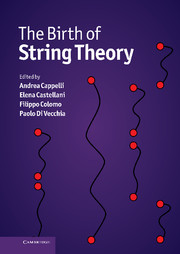Book contents
- Frontmatter
- Contents
- List of contributors
- Photographs of contributors
- Preface
- Abbreviations and acronyms
- Part I Overview
- EARLY STRING THEORY
- Part II The prehistory: the analytic S-matrix
- Part III The Dual Resonance Model
- Part IV The string
- TOWARDS MODERN STRING THEORY
- Part V Beyond the bosonic string
- 27 Introduction to Part V
- 28 From dual fermion to superstring
- 29 Dual model with fermions: memoirs of an early string theorist
- 30 Personal recollections
- 31 Aspects of fermionic dual models
- 32 The dual quark models
- 33 Remembering the dawn of relativistic strings
- 34 Early string theory in Cambridge: personal recollections
- Part VI The superstring
- Part VII Preparing the string renaissance
- Appendix A Theoretical tools of the Sixties
- Appendix B The Veneziano amplitude
- Appendix C From the string action to the Dual Resonance Model
- Appendix D World-sheet and target-space supersymmetry
- Appendix E The field theory limit
- Index
27 - Introduction to Part V
from Part V - Beyond the bosonic string
Published online by Cambridge University Press: 05 May 2012
- Frontmatter
- Contents
- List of contributors
- Photographs of contributors
- Preface
- Abbreviations and acronyms
- Part I Overview
- EARLY STRING THEORY
- Part II The prehistory: the analytic S-matrix
- Part III The Dual Resonance Model
- Part IV The string
- TOWARDS MODERN STRING THEORY
- Part V Beyond the bosonic string
- 27 Introduction to Part V
- 28 From dual fermion to superstring
- 29 Dual model with fermions: memoirs of an early string theorist
- 30 Personal recollections
- 31 Aspects of fermionic dual models
- 32 The dual quark models
- 33 Remembering the dawn of relativistic strings
- 34 Early string theory in Cambridge: personal recollections
- Part VI The superstring
- Part VII Preparing the string renaissance
- Appendix A Theoretical tools of the Sixties
- Appendix B The Veneziano amplitude
- Appendix C From the string action to the Dual Resonance Model
- Appendix D World-sheet and target-space supersymmetry
- Appendix E The field theory limit
- Index
Summary
Introduction
Part V deals with the extensions of the Dual Resonance Model (DRM), i.e. the bosonic string, to include additional symmetries and degrees of freedom. These generalizations were originally motivated by the need to overcome the drawbacks of the DRM and obtain a more realistic model of hadrons. Such attempts were only partially successful, though, with hindsight, we can say that they added some essential elements for the construction of modern string theory.
One of the first modifications of the Koba–Nielsen amplitude aimed at incorporating the internal flavour symmetry of hadrons, and was proposed by Chan and Paton in 1969. As discussed in Section 27.2, these authors showed that an internal flavour symmetry can be introduced simply by multiplying the amplitudes by appropriate group theoretical factors. Such factors can be viewed as resulting from the presence of a quark–antiquark pair attached to the open string end-points, and carrying flavour quantum numbers.
However, the incorporation of flavour symmetry was not the only open issue. As discussed in the previous Parts, the main problems of the DRM were: (i) the presence of a tachyon; (ii) the absence of fermions, preventing the description of baryons; (iii) the presence of a critical dimension with an unrealistic value, d = 26. Attempts to solve these problems started very early, in fact immediately after the appearance of the Veneziano formula, and went on more or less in parallel with the understanding of the DRM and its reinterpretation as a quantum string (see Parts III and IV).
Information
- Type
- Chapter
- Information
- The Birth of String Theory , pp. 331 - 345Publisher: Cambridge University PressPrint publication year: 2012
